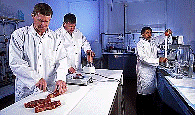United States Department of Agriculture: Agricultural Research Service, Lincoln, Nebraska

Roman L. Hruska U.S. Meat Animal Research Center: Reports
Date of this Version
2006
Document Type
Article
Citation
J. Anim. Sci. 2006. 84:1310–1316
Abstract
The objectives of this study were to evaluate the accuracy of the Decision Evaluator for the Cattle Industry (DECI) and the Cornell Value Discovery System (CVDS) in predicting individual DMI and to assess the feasibility of using predicted DMI data in genetic evaluations of cattle. Observed individual animal data on the average daily DMI (OFI), ADG, and carcass measurements were obtained from postweaning records of 504 steers from 52 sires (502 with complete data). The experimental data and daily temperature and wind speed data were used as inputs to predict average daily feed DMI (kg) required (feed required; FR) for maintenance, cold stress, and ADG; maintenance and cold stress; ADG; maintenance and ADG; and maintenance alone, with CVDS (CFRmcg, CFRmc, CFRg, CFRmg, and CFRm, respectively) and DECI (DFRmcg, DFRmc, DFRg, DFRmg, and DFRm, respectively). Genetic parameters were estimated by REML using an animal model with age on test as a covariate and with genotype, age of dam, and year as fixed effects. Regression equations for observed on predicted DMI were OFI = 1.27 (SE = 0.27) + 0.83 (SE = 0.04) × CFRmcg [R2 = 0.44, residual SD (sy.x) = 0.669 kg/d] and OFI = 1.32 (SE = 0.22) + 0.8 (SE = 0.03) × DFRmcg (R2 = 0.53, sy.x = 0.612 kg/d). Heritability of OFI was 0.27 ± 0.12, and heritabilities ranged from 0.33 ± 0.12 to 0.41 ± 0.13 for predicted measures of DMI. Phenotypic and genetic correlations between OFI and CFRmcg, CFRmc, CFRg, CFRmg, CFRm, DFRmcg, DFRmc, DFRg, DFRmg, and DFRm were 0.67, 0.73, 0.41, 0.63, 0.78, 0.73, 0.82, 0.45, 0.77, and 0.86 (P < 0.001 for all phenotypic correlations); and 0.95 ± 0.07, 0.82 ± 0.13, 0.89 ± 0.09, 0.95 ± 0.07, 0.91 ± 0.09, 0.96 ± 0.07, 0.89 ± 0.09, 0.88 ± 0.09, 0.96 ± 0.06, and 0.96 ± 0.07, respectively. Phenotypic and genetic correlations between CFRmcg and DFRmcg, CFRmc and DFRmc, CFRg and DFRg, CFRmg and DFRmg, and CFRm and DFRm were 0.98, 0.94, 0.99, 0.98, and 0.95 (P < 0.001 for all phenotypic correlations), and 0.99 ± 0.004, 0.98 ± 0.017, 0.99 ± 0.004, 0.99 ± 0.005, and 0.97 ± 0.021, respectively. The strong genetic relationships between OFI and CFRmcg, CFRmg, DFRmcg, and DFRmg indicate that these predicted measures of DMI may be used in genetic evaluations and that DM requirements for cold stress may not be needed, thus reducing model complexity. However, high genetic correlations for final weight with OFI, CFRmcg, and DFRmcg suggest that the technology needs to be further evaluated in populations with genetic variance in feed efficiency.


Comments
Copyright 2006 American Society of Animal Science. All rights reserved.